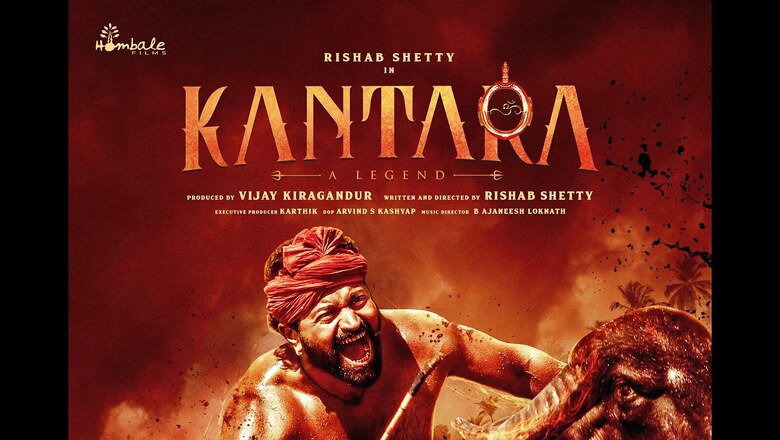
views
“This land is our land. The daiva has given it to us. We are its custodians.” When the villagers repeatedly say this to the landlords over decades in Kantara, it echoes the personal experience of Rishab Shetty, the director-actor of the Kannada movie that is currently wowing audiences nationwide. The forest officer who declares the inhabitants as encroachers and starts a survey to redraw the forest circumference doesn’t understand this basic philosophy. The deity/daiva protects the forest and its inhabitants, who in turn tend to it, and depend on it for their living. It is a symbiotic relationship between humans and nature, and the daiva is the bridge.
Kantara illustrates this beautifully. Much as Shetty’s Shiva runs away from his destiny of being a Bhoot Kola performer, something his father excelled at, the more it chases him down, until a glorious finale where humanity, nature and the spiritual world all meet to restore the essential order of things where all the elements work together and the human is but a small cog in the great wheel of life. In a symbolic extending of hands, the Shetty in his Bhoot Kola avatar shakes hands with the forest officer and the villagers join in, in a unique hand huddle.
The strong sentiment for land imbues some of the biggest hits of the last two years. In RRR, Komaram Bheem, like the rest of his people, lives in complete harmony with the jungle. As the song Bheemudu says: “Bheema, the earth which has given birth to you/the trees which give you air to breathe/Your Gond tribe which has given you a name are all talking to you? Can you hear them?”
Bheema, played by Junior NTR, is a child of the forest, and in reality, was one of the greatest folk heroes of Telangana. His stories were among those that SS Rajamouli would hear from his grandmother. And it was his father V Vijayendra Kumar, and he, who co-wrote the fiction where Bheema meets Alluri Sitarama Raju, another revolutionary leader, from Andhra Pradesh, in RRR.
In Pushpa: The Rise, again it is Pushpa’s mastery over the forest that makes him an excellent henchman to any sandalwood smuggler, until he becomes the boss himself. In KGF2, it is the ability of Rockybhai to see a “samrajya” (kingdom) where his aides can see only “dust and mud”.
Their distance from their village is never too much. Their language, their imagination and their innovation is all sparked by their surroundings. In Pushpa, when Allu Arjun is articulating the laws of survival in the song Daakko Daakko Meka, he says: “Goat has to find a place to hide, if it doesn’t want to be the tiger’s next lunch.”
He knows the forest inside out, from the way a dam can prevent water from flowing out, to which pond can be a perfect hiding place for the red sandalwood. In KGF, Rockybhai’s life before coming to the city is a rich one, riddled with poverty but overflowing with his mother’s love.
It is the same memory of another place, a different land that Vijay would carry with him in Deewar (1975), before coming to work in the docks. This is what much of India relates to, migrants themselves in search of food and work wherever they can find it. Up until the rise of the multiplexes, which split audiences down the middle, Mumbai movies maintained that connect with the land, the village, the original home, even in a youthful movie like Maine Pyaar Kiya (1989) where Prem goes to a village to earn his living as a construction worker.
In the post-millennial movies made from Mumbai, land is not something that is a living, breathing being. It is now not even a memory. Most of its directors and producers come from either film families or cities and towns. They have very little connection with the soil. In the movie industries in the South, the connection with the earth that nurtures us has not been broken. Shetty shot the movie “just two minutes away” from where he grew up in Keradi, a village in Karnataka. Several extras in the movie are actual villagers who were trained in a workshop he held there.
As a child he performed bit parts in ‘Yakshagana’, the Kannada art form that dramatises the Ramayana and the Mahabharata. Shetty, who both directed and acted in the movie, has used that training to perform the Bhoot Kola dance with great passion. The Bhoot Kola involves dance, ritual and elaborate performances in old Tulu to worship the daiva. Shetty watched more than 1,000 videos of the Bhoot Kola performance to get it right before training for it. And then, he just didn’t think too much, he adds. “I just went with the flow.”
Indeed. There is nothing artificial or exotic about Kantara. It is true to its origins, its roots and its identity.
The author is a senior journalist and former editor of India Today magazine. The views expressed in this article are those of the author and do not represent the stand of this publication.
Read all the Latest Opinions here


















Comments
0 comment